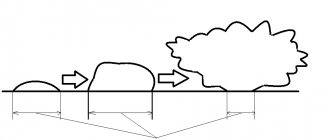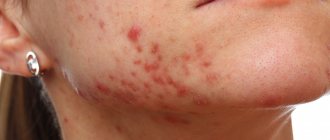People have many spots on their skin. A huge number of them may not even come into our field of vision. The attitude towards them is also ambiguous, one group of people does not even notice, while the other considers them a kind of decoration and an object of admiration. However, in addition to the decorative effect, nevi carry an important functional load, and inflammation of the mole can lead to undesirable consequences. If the mole turns red or the mole becomes inflamed and hurts, you should urgently consult a doctor, as there is a risk that the inflamed spot will degenerate into a malignant tumor. And in this case we will talk about such an aggressive disease as melanoma.
Changes in the condition of a mole, a good reason for concern
Is it dangerous to have pus in a mole?
The danger of pus in a mole is low. Indicates an infectious skin infection. A sign that the body is struggling with a problem. Harmful cells are removed with pus.
It is dangerous to ignore the alarm signal and squeeze out the white abscess on your own. If the outcome is favorable, it will lead to the formation of a new purulent growth, otherwise it will lead to severe inflammation, thickening of the skin and pain.
The appearance of white liquid near or in the formation itself is not a reason to consult a doctor. An abscess on a mole may turn out to be an ordinary pimple.
A cause for concern is the long-term presence of pus and its increase. Especially if redness, tingling, or pain appears at the site of the birthmark.
Prevention
To reduce the risk of moles becoming suppurated, it is important to avoid systematically injuring them, rubbing them against clothing, or scratching them. It is important to promptly treat skin diseases, diseases of internal organs, and immunodeficiencies.
For people with nevi, it is best to avoid prolonged exposure to direct sunlight or moderate sunbathing.
Pus in a mole is the main symptom of inflammation caused by a skin infection or bacteria. Can occur at any time. At first it hides under the guise of a pimple. Without appropriate treatment at an early stage, it can only be cured by surgery.
Causes of pus
An abscess, purulent inflammation in a nevus appears as a result of penetration of bacteria or infection into the skin. A birthmark is not a vulnerable spot, but a special condition of the skin with a high content of melanin pigment.
Reasons preceding the decay of a mole:
- A cut, scrape or abscess that has been exposed to dust, dirt or harmful germs.
- A skin disease characterized by inflammatory processes (acne, furunculosis, etc.).
- Burns, skin trauma, causing necrosis of the layers of the epidermis and basal cell carcinoma.
- Excessive exposure to the sun in hot weather is fraught with the harmful effects of ultraviolet rays.
- Skin irritation caused by rubbing clothes, scratching with nails.
People with freckles and unusually pigmented skin are especially susceptible to the disease. It is recommended to spend hot daytime in the shade and avoid long stays in stuffy rooms.
It is possible for a mole to spontaneously transform into a malignant tumor. Preceded by hormonal imbalances or nervous breakdowns.
The main danger is that degeneration is difficult to recognize. Symptoms appear after the disease develops. Treatment will require radical surgical intervention.
A boil under a mole is recognized by an increase in the size of the pigment spot and a sharp change in the usual color.
Treatment
First of all, the root cause of nevus suppuration, that is, the causative agent of the disease, is identified. In case of bacterial infection, the mole is treated with various ointments based on antibiotics and strong aseptic agents.
Since there is a risk of nevi degenerating into malignant formations and any inflammatory processes in them can provoke this, it is necessary to show the suppuration to a dermatologist or oncologist, undergo a full examination and follow all the instructions of specialists in the treatment of inflammation. Self-medication in such cases can only cause harm and cause serious complications.
Surgical removal of moles may be recommended in cases where they are constantly injured and have become inflamed more than once. Modern methods of eliminating them are laser exposure or cryofreezing.
With laser destruction, moles are destroyed with a directed beam, which heats their cells and they evaporate. After such an operation, a small scar remains, which resolves in less than a week.
What to do if a boil has formed under a mole
If there is strong pigmentation on the face, a red halo, swelling, abscesses around the mole, you cannot try to release the abscess on your own. Additionally, it will damage the skin and cause inflammation.
Allowed to do it yourself:
- free the skin from stale and chafing clothing. If it is a head, discard the headdress;
- isolate the site of inflammation from external contact, even covering it with a band-aid during a shower;
- hide the boil from sunlight;
- avoid stuffy rooms and any skin irritants (if you have allergies, get rid of the allergen);
- Check the mole periodically for increased pus, discoloration, or redness.
In order not to provoke the appearance of a malignant tumor, you should avoid cosmetics during your illness. It clogs pores and prevents skin cells from breathing normally and exchanging substances.
Do the same with creams, ointments and poultices. Independent use of traditional medicine will aggravate the course of the disease with new problems.
Self-medication is the path to surgery, a scar, and long rehabilitation.
Risk factors
According to recent, numerous scientific experiments, it was found that women, unlike men, have a greater tendency to develop melanoma. It is important to highlight that a malignant tumor can be localized separately on an area of the skin or on the nevus itself. Most often, the legs are affected by the pathological process, and a little less often the upper limbs and abdomen. A mole on the face and neck can also become inflamed, swollen, fester and cause many other problems.
People who are characterized by fair skin covered with freckles, as well as patients with a hereditary predisposition, constitute the main risk group. It is in these people that inflammation of the nevus or redness of the mole can result in malignant degeneration.
The above category of people should undergo regular examination by an oncologist and pay maximum attention to any change in the birthmark.
Pale skin and freckles are one of the risk factors for melanoma
How to remove inflammation
Purulent inflammation has dangerous consequences. Accompanied by pain without touch or exposure to the sun. The site of inflammation is itchy, painful and constantly hot.
You should act according to the recommendations of an oncologist or dermatologist. For instant pain relief, turn to universal folk and classical methods.
| Means | Mode of application | How many times a day | How does it work |
| Alcohol or alcohol tincture | Moisten the area of the hanging mole | 1 to 3 times | Disinfects the wound, eliminates the symptoms of inflammation |
| Tincture of homemade herbs (yarrow, ginger, etc.) | Wipe or apply lotion | 3 times a day | Knits, eliminates inflammation |
| Ointment with zinc, salicylic acid | Lubricate boils and scratches | 1 time | Kills harmful bacteria |
| Hydrogen peroxide | For open boils, soak with cotton wool. | 1-2 times for 7-10 minutes | Disinfects and cleanses the wound from harmful bacteria |
| Antiseptic | Grind into powder, lubricate (if tablet) | 1 time for wound post-treatment | Kills germs |
A scratch, injury, stye, scrape or abrasion can cause bleeding that is difficult to stop.
Immediately fix the wound and apply a sterile bandage moistened with hydrogen peroxide or alcohol.
What not to do if a boil appears under a nevus:
- try to release the pus on your own;
- remove inflammation yourself. Performed by a surgeon without any health consequences;
- try to hide with cosmetics;
- scratch the itchy area;
- contact with long-haired animals to avoid infection.
Signs and diagnosis
The discharge of pus from a mole is accompanied by a number of characteristic symptoms:
- the appearance of redness and pronounced swelling around the nevus;
- swelling or protrusion in the area of the mole;
- painful to touch and at rest.
Sometimes the following may be observed: a rise in body temperature to moderate levels (up to 37-37.7), the appearance of lethargy and weakness, skin itching and burning, blood from a mole.
When a mole has festered, it is not recommended to use a biopsy (taking a piece of it for histological examination), since this manipulation can contribute to the spread of infection to neighboring areas.
Usually, in such cases, a dermoscope is used and the festering tumors are examined in detail.
To determine the type of pathogenic microorganisms, scrapings are taken from the areas of the skin closest to inflammation.
When to see a doctor
The consequence of the appearance of pus is melanoma - skin cancer. A timely visit to dermatology or an oncologist will get rid of the abscess under the mole quickly and painlessly.
Symptoms for urgent medical attention:
- Increase in size, change in borders, colors.
- Thick skin with pain when touched.
- Cracks, ulcers, abscesses on the surface, near the birthmark. They begin to fester.
- The wound bleeds periodically.
- Unreasonable fatigue, amorphousness.
- Uncontrolled weight loss.
Signs of complications, the appearance of tumors in the human body. Early detection will reduce the damage done to the body.
Instructions for identifying a tumor:
- visual analysis;
- computer diagnostics;
- biopsy (removal of skin for laboratory analysis).
Melanoma
This is a type of cancer that occurs due to direct exposure to ultraviolet rays on the pigment cells of the skin. Melanoma is a dangerous disease. This is due to two reasons:
- the ability of a nevus to become an atypical neoplasm in a short time,
- the appearance of such a neoplasm leads to the appearance of a disease such as cancer.
If a mole becomes inflamed (red and hurts) or there is redness around the mole, this is a direct reason to seek help from a specialist.
The general clinical picture can be supplemented by:
- uneven edges,
- one half of the nevus is different from the other,
- heterogeneous coloring of the nevus,
- redness around the mole,
- nevus compaction.
In case of untimely diagnosis or unwillingness to consult a doctor in a timely manner, symptoms appear that indicate the active activity of the malignant process:
- the formation of numerous cracks on the surface of the nevus,
- blood comes from the nevus,
- significant weight loss.
There are also multiple enlargements of the lymph nodes and the appearance of corresponding pain upon palpation.
Dangerous moles that degenerate into melanoma
Preventive measures
It is easy to injure a mole due to carelessness. Therefore, it is important to monitor the neatness of your manicure and the comfort of your clothing. Rough, uncomfortable clothes and shoes with straight collars have a negative impact on skin tumors, and long nails can cause scratching of the birthmark. Constant trauma can provoke mutation of nevus cells and further degeneration into a malignant formation.
The proposed treatment methods are effective when it is necessary to treat a festering mole. But, I would like to draw your attention once again to the fact that the inflammatory process, and even more so the decay process, cannot be ignored and left to chance, so at the first signs you need to go to the doctor as soon as possible. Modern treatment allows you to get rid of the problem quickly and efficiently.
How are cutaneous and subcutaneous metastases diagnosed?
Sometimes skin metastases can be the first manifestation of cancer, while the primary malignant tumor does not cause symptoms. In other cases, they appear after the patient is diagnosed with cancer with metastases in other organs. Also, metastatic skin lesions can be the first sign of relapse, and this often occurs a long time after surgery. The average time interval from diagnosis of the primary tumor to the appearance of skin metastases is 2–3 years, but longer intervals of up to 22 years have been described.
Skin metastases are often difficult to diagnose and can be easily confused with primary benign and malignant skin tumors, infections, eczema, and vasculitis. Dermatologists play an important role, since it is usually to them that such patients turn first.
If metastatic skin lesions are suspected, an excisional biopsy is performed. The pathological focus is completely removed and histological examination is carried out. To determine which malignant tumor the metastasis originated from, immunohistochemical analysis is performed. Certain marker proteins help identify the primary neoplasm.
Possible complications
The roots of the mole are deep in the skin. The consequences of penetration of a fungal or viral infection are fatal not only for the upper layers of the epithelium. A striking example is blood poisoning through an open, inflamed wound.
Skin diseases include dermatosis - a fungal disease of the skin. The consequences are itching, redness, and boils.
Furunculosis is the manifestation of dead accumulations of cells on the entire surface of the skin. In the absence of treatment, local abscesses appear, squeezed out by a dense core of secretions.
Any complications lead to surgery. If the development of oncology has not reached its peak, the virus has not had time to penetrate deeply, gentle treatment is possible. Includes:
- use of ointments and creams (including hormonal);
- Laser birthmark removal.
Replacing a scalpel with a laser is a modern, painless and effective solution. Under the influence of rays, the layers of the mole gradually evaporate, leaving no scars or traces of the disease. Relevant for neck and face. Therapy is possible with early consultation with a doctor.
Purulent nevus is in most cases a pathology indicating the presence of neoplasms in the human body. Accompanied by an abscess, the appearance of purulent discharge, itching, pain, and redness of the skin around the nevus.
If you cannot see a doctor, use alcohol, peroxide, ointments with zinc and salicylic acid to disinfect the wound. Contraindications are: scorching sun, tight clothing, tactile contact with nails, buttons and other similar objects.
Everyone knows that nevi are pigmented neoplasms that are a benign tumor. But what is the correct action if pus comes out of a mole? The first step is to provide primary care, and then consult a dermatologist or oncologist to obtain information about the cause of ill health.











